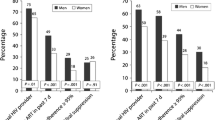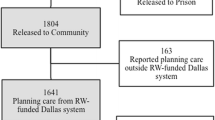Abstract
Approximately 17% of individuals living with HIV/AIDS pass through the correctional system each year. Jails provide a unique opportunity to diagnose and treat HIV infection among high-risk, transient populations with limited access to medical services. In 2007, the US Health Resources and Services Administration funded a multi-site demonstration project entitled Enhancing Linkages to HIV Primary Care in Jail Settings that aims to improve diagnosis and treatment services for HIV-positive jail detainees and link them to community-based medical care and social services upon release. We performed an evaluation of the Rhode Island demonstration site entitled Community Partnerships and Supportive Services for HIV-Infected People Leaving Jail (COMPASS). Through in-depth qualitative interviews among 20 HIV-positive COMPASS participants in Rhode Island, we assessed how COMPASS impacted access to health care and social services utilization. Most individuals were receiving HIV treatment and care services upon enrollment, but COMPASS enhanced linkage to medical care and follow-up visits for HIV and other co-morbidities for most participants. Several participants were successfully linked to new medical services as a result of COMPASS, including one individual newly diagnosed with HIV and another who had been living with HIV for many years and was able to commence highly active antiretroviral therapy (HAART). While many individuals reported that COMPASS support prevented substance abuse relapse, ongoing substance abuse nevertheless remained a challenge for several participants. Most participants enrolled in one or more new social services as a result of COMPASS, including Medicaid, Supplemental Security Income, food assistance, and housing programs. The primary unmet needs of COMPASS participants were access to mental health services and stable housing. Intensive case management of HIV-positive jail detainees enhances access to medical and social support services and helps prevent relapse to substance abuse. Expanding intensive case management programs, public housing, and mental health services for recently released HIV-positive detainees should be public health priorities.
Similar content being viewed by others
References
Glynn M, Rhodes P. Estimated HIV prevalence in the United States at the end of 2003 [Abstract No. T1-B1101]. National HIV Prevention Conference. Atlanta, GA, June 12–15, 2005.
Fleming P, Byers R, Sweeney P, Karon J, Janssen RS. HIV prevalence in the United States, 2000. Programs and Abstracts of the 9th Conference on Retroviruses and Opportunistic Infections. Seattle, Washington: Abstract 11; February 24–28, 2002.
Spaulding AC, Seals RM, Page MJ, Brzozowski AK, Rhodes W, Hammett TM. HIV/AIDS among inmates of and releasees from US correctional facilities, 2006: declining share of epidemic but persistent public health opportunity. PLoS ONE. 2009;4(11):e7558.
Maruschak L. HIV in prisons, 2006. US Department of Justice, Bureau of Justice Statistics. NCJ-222179.
Visher C, LaVigne N, Travis J. Returning home: understanding the challenges of prisoner reentry. Maryland Pilot Study: findings from Baltimore: Urban Institute, Justice Policy Center; January 2004. JPC Publication CPR04 0122.
Kushel MB, Hahn JA, Evans JL, Bangsberg DR, Moss AR. Revolving doors: imprisonment among the homeless and marginally housed population. Am J Public Health. 2005;95(10):1747–1752.
Cooke CL. Going home: formerly incarcerated African American men return to families and communities. J Fam Nurs. 2005;11(4):388–404.
Courtenay-Quirk C, Pals SL, Kidder DP, Henny K, Emshoff JG. Factors associated with incarceration history among HIV-positive persons experiencing homelessness or imminent risk of homelessness. J Community Health. 2008;33(6):434–443.
Cooke CL. Joblessness and homelessness as precursors of health problems in formerly incarcerated African American men. J Nurs Scholarsh. 2004;36(2):155–160.
Stephenson BL, Wohl DA, McKaig R, et al. Sexual behaviours of HIV-seropositive men and women following release from prison. Int J STD AIDS. 2006;17(2):103–108.
MacGowan RJ, Margolis A, Gaiter J, et al. Predictors of risky sex of young men after release from prison. Int J STD AIDS. 2003;14(8):519–523.
van Olphen J, Eliason MJ, Freudenberg N, Barnes M. Nowhere to go: how stigma limits the options of female drug users after release from jail. Subst Abuse Treat Prev Policy. 2009;4:10.
Clements-Nolle K, Marx R, Pendo M, Loughran E, Estes M, Katz M. Highly active antiretroviral therapy use and HIV transmission risk behaviors among individuals who are HIV infected and were recently released from jail. Am J Public Health. 2008;98(4):661–666.
Stephenson BL, Wohl DA, Golin CE, Tien HC, Stewart P, Kaplan AH. Effect of release from prison and re-incarceration on the viral loads of HIV-infected individuals. Public Health Rep. 2005;120(1):84–88.
Small W, Wood E, Betteridge G, Montaner J, Kerr T. The impact of incarceration upon adherence to HIV treatment among HIV-positive injection drug users: a qualitative study. AIDS Care. 2009;21(6):708–714.
Friedman MS, Marshal MP, Stall R, et al. Associations between substance use, sexual risk taking and HIV treatment adherence among homeless people living with HIV. AIDS Care. 2009;21(6):692–700.
Royal SW, Kidder DP, Patrabansh S, et al. Factors associated with adherence to highly active antiretroviral therapy in homeless or unstably housed adults living with HIV. AIDS Care. 2009;21(4):448–455.
James D. Profile of jail inmates, 2002 US Department of Justice, Office of Justice Programs. Bureau of Justice Statistics, Special Report July 2004 NCJ 201932.
Freudenberg N. Jails, prisons, and the health of urban populations: a review of the impact of the correctional system on community health. J Urban Health. 2001;78(2):214–235.
Vlahov D, Putnam S. From corrections to communities as an HIV priority. J Urban Health. 2006;83(3):339–348.
Jacob Arriola KR, Braithwaite RL, Holmes E, Fortenberry RM. Post-release case management services and health-seeking behavior among HIV-infected ex-offenders. J Health Care Poor Underserved. 2007;18(3):665–674.
Zaller ND, Holmes L, Dyl AC, et al. Linkage to treatment and supportive services among HIV-positive ex-offenders in Project Bridge. J Health Care Poor Underserved. 2008;19(2):522–531.
Health Resources and Services Administration, US Department of Health and Human Services. The HIV/AIDS Bureau: Special Projects of National Significance (SPNS) Enhancing Linkages to Primary Care and Services in Jail Settings Demonstration Models. Announcement Number: HRSA-07-031. Available at https://grants.hrsa.gov/webExternal/DisplayAttachment.asp?ID=0553C8C6-91DE-4C09-9D5D-1B1BF572F8D7.
Spaulding A, Arriola K, Ramos K. Enhancelink: linking HIV infected jail detainees to care. American Correctional Health Services Association, Southeast Regional 2008 Professional Development Conference. Chattanooga, TN; September 19–21, 2008. Available at http://enhancelink.org/sites/hivjailstudy/ACHSA_fall_08_918.pdf.
Fontana L, Beckerman A. Recently released with HIV/AIDS: primary care treatment needs and experiences. J Health Care Poor Underserved. 2007;18(3):699–714.
Merriam SB. Qualitative research and case study applications in education. 2nd ed. San Francisco: Jossey-Bass; 1998.
Weiss RS. Learning from strangers: the art and method of qualitative interview studies. New York: Free Press; Toronto: Maxwell Macmillan Canada; Maxwell Macmillan International; 1994.
Maxwell JA. Qualitative research design: an interactive approach. 2nd ed. Thousand Oaks: Sage; 2005.
Seidman I. Interviewing as qualitative research: a guide for researchers in education and the social sciences. 3rd ed. New York: Teachers College Press; 2006.
Rich JD, Holmes L, Salas C, et al. Successful linkage of medical care and community services for HIV-positive offenders being released from prison. J Urban Health. 2001;78(2):279–289.
Desai AA, Latta ET, Spaulding A, Rich JD, Flanigan TP. The importance of routine HIV testing in the incarcerated population: the Rhode Island experience. AIDS Educ Prev. 2002;14(5 Suppl B):45–52.
Beckwith CG, Poshkus M, Chowdury S, et al. Routine jail-based HIV testing in Rhode Island, 2000-2007 [Presentation CCT4B-1]. 2009 National HIV Prevention Conference. Atlanta, GA, August 23-26, 2009.
CDC. Coinfection with HIV and hepatitis C virus. Atlanta: CDC; 2010.
Roux P, Carrieri MP, Villes V, et al. The impact of methadone or buprenorphine treatment and ongoing injection on highly active antiretroviral therapy (HAART) adherence: evidence from the MANIF2000 cohort study. Addiction. 2008;103(11):1828–1836.
Kapadia F, Vlahov D, Wu Y, et al. Impact of drug abuse treatment modalities on adherence to ART/HAART among a cohort of HIV seropositive women. Am J Drug Alcohol Abuse. 2008;34(2):161–170.
Greifinger R. Thirty years since Estelle v. Gamble. In: Greifinger R, ed. Public health behind bars: from prisons to communities. New York: Springer International; 2007.
Bruce RD. Methadone as HIV prevention: high volume methadone sites to decrease HIV incidence rates in resource limited settings. Int J Drug Policy. 2010;21(2):122–124.
Sullivan LE, Metzger DS, Fudala PJ, Fiellin DA. Decreasing international HIV transmission: the role of expanding access to opioid agonist therapies for injection drug users. Addiction. 2005;100(2):150–158.
Sullivan LE, Moore BA, Chawarski MC, et al. Buprenorphine/naloxone treatment in primary care is associated with decreased human immunodeficiency virus risk behaviors. J Subst Abuse Treat. 2008;35(1):87–92.
James D, Glaze L. Mental health problems of prison and jail inmates. US Department of Justice, Bureau of Justice Statistics. September 2006:NCJ 213600. Accessed at http://bjs.ojp.usdoj.gov/content/pub/pdf/mhppji.pdf.
Baillargeon JG, Paar DP, Wu H, et al. Psychiatric disorders, HIV infection and HIV/hepatitis co-infection in the correctional setting. AIDS Care. 2008;20(1):124–129.
Des Jarlais DC, Braine N, Friedmann P. Unstable housing as a factor for increased injection risk behavior at US syringe exchange programs. AIDS Behav. 2007;11(6 Suppl):78–84.
Shah NG, Galai N, Celentano DD, Vlahov D, Strathdee SA. Longitudinal predictors of injection cessation and subsequent relapse among a cohort of injection drug users in Baltimore, MD, 1988–2000. Drug Alcohol Depend. 2006;83(2):147–156.
Buchanan D, Kee R, Sadowski LS, Garcia D. The health impact of supportive housing for HIV-positive homeless patients: a randomized controlled trial. Am J Public Health. 2009;99(Suppl 3):S675–S680.
Acknowledgements
This manuscript was supported by the Special Projects of National Significance of the Health Resources and Services Administration (grant H97HA08535), and the Lifespan/Tufts/Brown Center for AIDS Research (grant P30AI42853). In addition, A. Nunn received support from the NIDA grant 5T32DA013911, NIAAA grant 1K01AA020228-01A1, and a Rhode Island Foundation Medical Research Grant. C. Beckwith received support from NIDA grant K23DA021095 and L. Bazerman received support from the Tufts Nutrition Collaborative, A Center for Drug Abuse, and AIDS Research (grant P30DA013868). None of the aforementioned agencies had any role in study design; in the collection, analysis, and interpretation of data; in the writing of the report; or in the decision to submit the paper for publication.
Author information
Authors and Affiliations
Corresponding author
Rights and permissions
About this article
Cite this article
Nunn, A., Cornwall, A., Fu, J. et al. Linking HIV-positive Jail Inmates to Treatment, Care, and Social Services After Release: Results from a Qualitative Assessment of the COMPASS Program. J Urban Health 87, 954–968 (2010). https://doi.org/10.1007/s11524-010-9496-7
Published:
Issue Date:
DOI: https://doi.org/10.1007/s11524-010-9496-7




